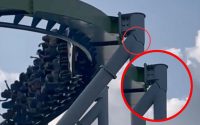US can’t say if Russia meant to bring down Black Sea drone
WASHINGTON — A day after a Russian jet sent an American military drone into the Black Sea following a mid-air collision, the top US general said Wednesday he did not know whether the impact was intentional.
While Gen. Mark Milley, the chairman of the Joint Chiefs of Staff, reiterated the initial US claim that two Su-27 pilots’ “aggressive” behavior while intercepting the MQ-9 Reaper led to its downing, he added that it “remains to be seen” whether one of them meant to strike the drone’s propeller.
“We know that the intercept was intentional. We know that the aggressive behavior was intentional — we also know was very unprofessional and very unsafe,” Milley said.
“The actual contact of the fixed-wing Russian fighter with our UAV [drone] – the physical contact with those two – [we’re] not sure yet.”
Milley’s comment came after Russian Ambassador to the US Anatoly Antonov claimed the Su-27s “did not come into contact with” the drone in a Telegram post late Tuesday, adding that Moscow scrambled the jets “to identify the intruder [and] did not use onboard weapons.”

Still, Milley said the US has “video evidence” of the Russian jets’ earlier “unsafe and unprofessional” actions during the encounter, including their unusual tactic of dumping fuel repeatedly on the drone in an apparent attempt to blind or damage the aircraft.
“I can tell you with certainty that we have absolute evidence of the contact, the intercepts, etc. and it’s very aggressive,” he said.
“You’ve heard about the dumping of the fuel and everything else — we have video evidence of all that, so there’s no question that that part of it [was] intentional.”
Asked whether the incident was an act of war, Milley replied: “I’m not gonna go there. Incidents happen.”
“Clearly, we do not seek armed conflict with Russia and I believe that at this point, we should investigate this incident and move on from there, but we will continue to exercise our rights in international airspace,” he added.
Defense Secretary Lloyd Austin discussed the incident with Russian Defense Minister Sergei Shoigu on Wednesday afternoon in their first phone call since October.
Austin declined to detail what the men discussed, but said he requested the call because “we take any potential for escalation very seriously.”
It was only the third publicly reported call between the defense officials since Russia invaded Ukraine on Feb. 24, 2022.
“I believe it’s important to keep the lines of communication open,” he said. “I think it’s really key that we’re able to pick up the phone and engage each other and I think that that will help to prevent miscalculation going forward.”

Milley also called his counterpart, Chief of the Russian General Staff Valery Gerasimov, on Wednesday evening, but no further details were released.
However, the Russian Defense Ministry said Austin and Shoigu’s call included “an exchange of views on the causes and consequences” of the drone’s crash into the Black Sea — shifting the blame to the US for flying near Crimea, which Russia illegally annexed from Ukraine in 2014 but which the US still recognizes as Kyiv’s territory.
“Sergei Shoigu pointed out that the incident was caused by the US actions of non-compliance with the flight restriction zone declared by the Russian Federation established in connection with the [war], as well as increased reconnaissance activities against the interests of the Russian Federation,” the ministry said in a statement.
The US does not recognize Russia’s self-declared restriction zone, and the Pentagon insists that the incident occurred in “international airspace.”
Shoigu also told Austin that Russia believes US drone flights “off the coast of Crimea are provocative in nature,” which the ministry warned “creates preconditions for the escalation of the situation in the Black Sea area.”
“The Russian Federation is not interested in such development, but it will continue to respond to all provocations in a proportionate manner,” the ministry said.
“At the same time, the major nuclear powers should act as responsibly as possible, including maintaining military channels of communication to discuss any crisis situations.

The statement echoed Antonov’s Tuesday post, in which he said he “categorically rejected all the insinuations of the US side” during a State Department meeting after the collision.
“The unacceptable actions of the United States military in the close proximity to our borders are cause for concern,” he said.
“We are well aware of the missions such reconnaissance and strike drones are used for.”
While Pentagon spokesman Brig. Gen. Pat Ryder on Tuesday admitted the drone was conducting a surveillance mission at the time, he said such flyovers have happened regularly since before the Ukraine war began.
Though US officials have not said whether the drone’s surveillance was related to the Ukraine war, Antonov on Tuesday claimed it was moving “provocatively” toward Crimea.
“What do [the drones] do thousands of miles away from the United States?” he said in the Telegram post.
“The answer is obvious — they gather intelligence which is later used by the [Kyiv] regime to attack our armed forces and territory.”


